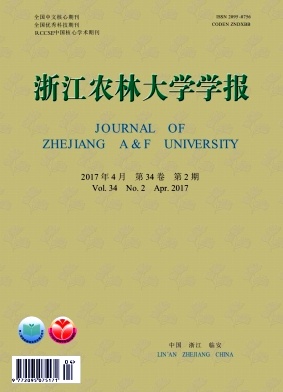-
森林是陆地生态系统的主体,在调节全球碳收支平衡、减少大气二氧化碳等温室气体浓度上升[1-2]等方面发挥重要作用。森林生态系统碳储量作为反映森林资源及生态环境效能的重要指标[3-4],对于正确认识森林生物碳储量对区域碳平衡及生态环境的影响具有重要意义[5]。土壤有机碳、氮是影响森林生长及碳库变化的重要组成元素[6-7],土壤碳氮比是衡量植物生长发育的重要指示性指标[8-9]。森林生态系统碳储量问题是当前的研究热点,对于特定的林分,不同的林分密度[10]、不同的生长阶段[11-13]森林碳储量均存在一定差别。森林经营措施的不同会对林分不同组分碳储量产生影响[14]。一般认为,混交林碳储量要高于纯林[15]。森林抚育作为重要的改善林木生长条件的经营措施,对森林生态系统生物量和碳储量有着重要的影响。抚育措施有利于提高马尾松Pinus massoniana乔木层生物量和碳储量,不利于林下地被物和凋落物生物量和碳的累积[16],而对现有林分进行抚育和管理,可以开发植被碳汇潜力[5]。栎类Quercus天然次生林是河南山区典型的落叶阔叶林,分布广泛,对保障河南生态安全、大径级木材培育具有重要的生态价值和经济价值。已有研究表明:森林抚育作为森林培育的重要经营措施,可以调整林分结构,降低林分密度,促进林分生长,改善林分生长环境[17-18],改变土壤元素循环过程,进而影响森林系统碳储量及其分布。森林抚育如何影响林分和土壤碳分布格局,进而影响生物量和碳储量的报道主要集中在人工针叶林[19-21],关于阔叶次生林的研究较少。本研究通过对栎类天然次生林进行森林抚育实验,设置不同抚育强度,调查乔木层、林下植被层、凋落物层和土壤层的碳、氮分布,分析抚育对栎类天然次生林的不同组分、土壤碳氮分布及碳储能力的影响,为开展碳次生林培育、大径级次生林培育、制定科学合理的森林抚育和可持续经营技术措施提供理论支撑。
HTML
-
研究区位于河南驻马店马道林场、三门峡甘山林场和济源邵原林场,分别处于豫南、豫西和豫北山区,分属桐柏山脉、伏牛山脉和太行山脉等栎类天然次生林在河南的主要分布区。该区属暖温带-亚热带、湿润-半湿润季风气候。年平均气温为12.0~16.0 ℃,无霜期为180.0~240.0 d,年降水量为500.0~900.0 mm,多集中在7-8月。森林群落建群种有栓皮栎Quercus variabilis,麻栎Quercus acutissima,锐齿槲栎Quercus alina var. acuteserrata,槲树Quercus dentata,槲栎Quercus aliena,油松Pinus tabulaeformis,马尾松等乔木树种。
-
选择生长条件基本一致的中幼龄栎类天然次生林,采用综合抚育方法对栎类天然次生林进行抚育,伐除对目标树生长有影响的干扰树和生长不良的受压木。根据抚育前后的林分密度,分为轻度(21%),中度(35%),重度(54%)和对照(0%)4个抚育处理,设置重复样地4个·处理-1,面积为0.067 hm2。
森林抚育2 a后进行样地调查。进行常规测树学调查,每块样地依据平均胸径确定平均木,进行树干解析和挖根(取样深度100 cm),测定树干、树枝、树叶、树皮和树根的鲜质量并取样,取样200~500 g·组分-1,称鲜质量后带回实验室在85 ℃下烘干至恒量,用于各组分单株生物量推算和元素测定。林下植被及凋落物采用全部收获法,在各个乔木样地内沿对角线设置3个1 m × 1 m的小样方,将样方内的林下植被全部挖起,分地上、地下部分称其鲜质量,并将3个样方内的地上、地下混合以及全部凋落物分别取样200 g左右,称鲜质量带回实验室在85 ℃下烘干至恒量,用于生物量推算和元素测定。在各个样地内选取具有代表性的地段设置土壤剖面,按照0~10 cm,10~20 cm分层环刀取样,同层土壤取混合样,将土壤样品带回实验室仪测定土壤碳、氮质量分数。样地概况如表 1。
处理 样地 坡位 坡度/(°) 坡向 海拔/m 抚育前林分密度/ (株·hm-2) 抚育后林分密度/ (株·hm-2) 平均胸径/cm 平均树高/cm 轻度 (21%) 1 上 18 西南 380 2 405 1 900 9.9 7.3 2 上 10 西南 378 2 532 2 000 10.7 8.9 3 中 18 西南 374 2 278 1 800 12.4 7.6 4 上 10 西南 378 2 405 1 900 9.8 7.4 中度 (35%) 5 中 18 西南 374 2 000 1 300 14.3 10.0 6 上 13 南 224 1 852 1 204 12.6 9.8 7 上 18 东 876 2 768 1 799 11.3 8.4 8 上 20 东 876 2 791 1 814 11.3 8.4 重度 (54%) 9 上 20 西 1 191 1 630 750 14.6 11.6 10 下 25 西 1 103 1 533 705 19.9 12.0 11 上 25 西南 923 2 324 1 069 11.8 8.2 12 上 20 南 224 2 337 1 075 10.7 9.1 对照 (0%) 13 上 20 西南 923 2 414 2 414 8.5 6.5 14 上 25 南 849 2 628 2 628 7.8 6.0 15 上 20 西南 923 2 414 2 414 8.3 5.2 16 上 20 西南 923 2 219 2 219 11.5 9.1 Table 1. Plot description of oak forests
-
对采集的植物和土壤样品中的有机碳、全氮质量分数分别采用重铬酸钾硫酸氧化法、半微量开氏法进行测定[22]。乔木层各组分全林生物量模型:
式(1)中:W为生物量(t·hm-2);D为胸径(cm);H为树高(m);a,b为常数。植物碳储量(SC)采用单位面积各组分生物量(W)与碳质量分数(wC)的乘积估算:
土壤碳储量计算公式:
式(3)中:SOC为土壤有机碳储量(t·hm-2);wOC为土壤有机碳质量分数(g·kg-1);ρ为土壤容重;h为土壤采样深度(cm)。
数据分析采用SPSS 19.0进行。
2.1. 样地设置与野外调查
2.2. 指标测定和计算
-
利用16株树干解析和单株各组分生物量测定数据,采用式(1)建立单株各组分生物量与胸径和树高的估算方程,用来估算全林分生物量。方程各参数及显著性检验结果见表 2。结果表明:单株干、皮、枝、叶、根与胸径和树高的回归方程相关系数都在0.972以上,方程显著性检验结果(P<0.05)表明,拟合方程能够很好描述栎类单株胸径、树高与各组分生物量的关系,可以用来估算单株各组分生物量,进而可以估算林分生物量。
组分 回归方程 R2 F P值 干 W=0.045 0(D2H)0.915 7 0.978 76.123 0.000 皮 W=0.025 0(D2H)0.702 5 0.982 10.571 0.024 枝 W=0.010 6(D2H)0.997 5 0.972 30.985 0.002 叶 W=0.019 1(D2H)0.801 1 0.981 9.526 0.005 根 W=0.021 1(D2H)0.893 2 0.992 40.129 0.001 Table 2. Biomass allometric equation of various component in the tree layer
-
由栎类天然次生林轻度、中度、重度3种抚育强度和对照的乔木层、林下植被和凋落物碳、氮质量分数(表 3)可知:不同抚育强度乔木层各组分碳、氮质量分数均随着抚育强度的增大而增加,其中乔木层干、皮、枝、叶和根的碳质量分数区间分别为431.41~453.39,433.54~454.66,428.88~438.15,482.17~495.72和401.75~411.53 g·kg-1;氮质量分数分别为2.79~3.26,9.11~9.97,3.67~4.99,13.99~15.20和3.83~4.84 g·kg-1。重度抚育栎类天然次生林乔木层各组分碳质量分数高于其他3种处理,且碳质量分数在乔木层不同组分之间分布规律为叶>皮>干>枝>根;氮质量分数在各组分之间分布规律为叶>皮>根>枝>干。
林分组成 碳/(g·kg-1) 氮/(g·kg-1) 对照 (0%) 轻度 (21%) 中度 (35%) 重度 (54%) 对照 (0%) 轻度 (21%) 中度 (35%) 重度 (54%) 乔
木
层干 431.41±25.47 c 446.79±31.78 b 447.82±36.55 b 453.39±28.01 a 2.79±0.13 c 2.93±0.74 b 2.93±1.00 b 3.26±0.75 a 皮 433.54±24.86 c 446.00±24.11 b 446.90±26.63 b 454.66±28.97 a 9.11±1.95 c 9.22±1.74 bc 9.37±1.25 b 9.97±2.56 a 枝 428.88±19.83 c 431.80±18.05 b 432.00±19.77 b 438.15±16.33 a 3.67±0.65 b 3.74±0.78 b 3.80±0.61 b 4.99±1.47 a 叶 489.61±16.80 b 482.17±16.77 c 488.12±18.65 b 495.72±17.22 a 13.99±2.48 b 14.12±3.47 b 14.22±2.97 b 15.20±3.56 a 根 401.75±20.78 b 402.00±19.83 b 402.89±20.47 b 411.53±21.84 a 3.83±0.32 b 3.90±1.46 b 4.07±1.36 b 4.84±0.85 a 林下 地上部分 421.01±30.74 b 422.39±35.23 b 42435±28.01 b 428.75±29.32 a 4.01±1.11 c 411±1.00 c 459±1.17 b 6.86±1.85 a 植被 地下部分 296.36±20.69 b 259.18±14.36 d 283.42±13.26 c 339.39±25.44 a 3.04±0.62 d 3.45±0.73 c 3.7±0.67 b 4.63±0.36 a 凋落物 321.70±18.30 a 311.71±21.36 b 308.94±30.96 b 298.00±27.15 b 8.37±2.88 c 9.01±2.84 b 9.40±2.12 b 10.79±3.06 a 说明:表中数值为平均值±标准差。不同小写字母表示不同抚育强度乔木层各组成碳含量、氮质量分数的差异显著 (P<0.05) Table 3. Carbon content of tree layer, forest vegetation and litters
林下植被地上部分和地下部分碳质量分数分布区间为421.01~428.75和259.18~339.39 g·kg-1,氮质量分数分布区间为4.01~6.86和3.04~4.63 g·kg-1。4种抚育强度栎类天然次生林地上部分碳、氮质量分数均高于地下部分,且随着抚育强度的增大而增加。重度抚育栎类天然次生林地下部分碳、氮质量分数最大,分别为339.39和4.63 g·kg-1,碳呈现出随着抚育强度的增大先降低后增加,氮随着抚育强度的增大而增加。不同抚育强度林分凋落物碳、氮质量分数分布区间为298.00~321.70和8.37~10.79 g·kg-1,其中碳质量分数呈现出随着抚育强度增大而降低,氮含量则呈现相反的变化趋势。
-
由不同抚育强度栎类天然次生林碳氮比分布(图 1)可知:除树皮外,干、枝、叶、根碳氮比在对照、轻度、中度抚育时没有显著差异(P>0.05),而重度抚育碳氮比显著最小(P<0.05),分别为139.2,87.8,32.6,85.0。不同抚育强度林下植被碳氮比分布呈现一定的规律,即地上部分对照、轻度抚育碳氮比显著大于中度和重度抚育(P<0.05),重度抚育时碳氮比值最小,其值为62.5;地下部分对照碳氮比值显著大于轻度、中度、重度抚育(P<0.05)。不同抚育强度凋落物碳氮比大小顺序为:对照>轻度>中度>重度,分别为34.6,32.9,27.6,38.4,重度抚育时碳氮比值显著最小(P<0.05),为27.6。由此可见,通过森林抚育后,林分不同组分之间的碳、氮质量分数均有一定的增加,但是碳质量分数增加幅度小于氮质量分数的增加幅度。这说明与对碳质量分数的影响相比,森林抚育对于氮质量分数的影响更大。
-
从表 4可以看出:不同抚育强度栎类天然次生林乔木层、林下植被层和凋落物层生物量和碳储量的分布规律为:乔木层>凋落物层>林下植被层。轻度、中度、重度、对照4种抚育强度下,栎类天然次生林乔木层生物量分别为48.86,74.20,114.93和33.31 t·hm-2,碳储量分别为21.42,32.62,51.24,14.35 t·hm-2,生物量和碳储量均随抚育强度的增大而增加。轻度、中度和重度抚育强度栎类天然次生林乔木层各组分生物量和碳储量均高于对照,大小顺序为重度>中度>轻度>对照。可见森林抚育措施通过改善林分生长环境,促进了林木快速生长,增加了林分生长量,有利于碳储能力的提高。
林分组成 生物量/(t·hm-2) 碳储量/(t·hm-2) 对照 (0%) 轻度 (21%) 中度 (35%) 重度 (54%) 对照 (0%) 比例/% 轻度 (21%) 比例/% 中度 (35%) 比例/% 重度 (54%) 比例/% 乔
木
层干 15.51± 22.86± 34.88± 54.25± 6.69± 46.62 10.21± 47.67 15.62± 47.88 24.60± 48.00 9.60 d 5.27 c 10.24 b 36.72 a 4.14 d 2.35 c 4.59 b 16.65 a 皮 2.16± 2.97± 4.09± 5.61± 0.94± 6.55 1.32± 6.16 1.83± 5.61 2.55± 4.98 1.00 c 0.52 c 0.92 b 2.93 a 0.43 c 0.23 bc 0.41 b 1.33 a 枝 6.23± 9.41± 14.93± 24.47± 2.67± 18.61 4.06± 18.95 6.45± 19.77 10.72± 20.92 4.24 d 2.36 c 4.78 b 17.96 a 1.82 d 1.02 c 2.07 b 7.87 a 叶 3.12± 4.44± 6.42± 9.31± 1.53± 10.66 2.14± 9.99 3.13± 9.60 4.61± 9.00 1.67 c 0.90 c 1.64 b 5.54 a 0.82 c 0.43 c 0.80 b 2.74 a 根 6.28± 9.19± 13.88± 21.29± 2.52± 17.56 3.69± 17.23 5.59± 17.14 8.76± 17.10 3.78 d 2.07 c 3.97 b 14.07 a 1.52 d 0.83 c 1.60 b 5.79 a 合计 33.31 d 48.86 c 74.2 b 114.93 a 14.35 d 100 21.42 c 100 32.62 b 100 51.24 a 100 林下 地上 0.27± 0.52± 1.14± 1.65± 0.11± 26.19 0.22± 45.83 0.48± 35.04 0.71± 44.65 0.40 d 0.02 c 1.22 b 1.80 a 0.17 d 0.01 c 0.52 b 0.77 a 植被 地下 1.05± 0.99± 3.13± 2.60± 0.31± 73.81 0.26± 54.17 0.89± 64.96 0.88± 55.35 2.05 c 0.14 c 4.20 a 1.71 b 0.16 b 0.04 b 0.50 a 0.73 a 合计 1.32b 1.51 b 4.27 a 4.25 a 0.42 c 100 0.48 c 100 1.36 b 100 1.59 a 100 凋落物 29.69± 25.50± 20.62± 17.05± 9.55± 7.95± 6.37± 5.08± 1.49 a 3.31 b 5.63 c 3.03 d 0.48 a 1.03 b 1.30 c 0.90 c 说明:小写字母表示不同抚育强度乔木层各组分、林下植被层、凋落物层的生物量和碳储量差异性显著 (P<0.05) Table 4. Biomass, carbon storage and distribution characteristics of tree layer, forest vegetation and litters
不同抚育强度栎类天然次生林乔木层各组分碳储量大小关系均为:干>枝>根>叶>皮,其中树干的碳储量最大,在轻度、中度、重度和对照4个抚育强度林分中,分别占乔木层碳储量比例为47.67%,47.88%,48.00%和46.62%;树枝碳储量在4个抚育强度林分中所占乔木层碳储量比例为18.00%~21.00%;树皮碳储量占乔木层碳储量比例最小,低于7.00%。
不同抚育强度栎类天然次生林林下植被地上部分生物量和碳储量均小于地下部分,因此,林下植被地下部分碳储可被看做是森林生态系统碳库的重要组成部分。轻度、中度、重度、对照等4种抚育强度林下植被的生物量分别为1.51,4.27,4.25和1.32 t·hm-2,碳储量分别为0.48,1.36,1.59,0.42 t·hm-2,其中中度和重度抚育林分林下植被生物量无显著差异,因此重度抚育时林下植被生物量和碳储量最高。
凋落物层在轻度、中度、重度抚育和对照林分的生物量分别为25.50,20.62,17.05,29.69 t·hm-2,碳储量分别为7.95,6.37,5.08,9.55 t·hm-2。可以看出:经过森林抚育的凋落物生物量和碳储量均小于对照,且轻度>中度>重度,这说明森林抚育措施主要是促进了林木生长和林下植被生物量的增加,但是却降低了凋落物产生,导致凋落物总的现存量减少。
-
表 5为不同抚育强度不同土层厚度栎类天然次生林土壤有机碳、全氮质量分数及有机碳碳储量。由表 5可以看出:土壤有机碳、全氮质量分数及有机碳碳储量具有明显的垂直分布特征,土壤表层(0~10 cm)有机碳质量分数、全氮质量分数和有机碳储量均显著高于10~20 cm土层(P<0.05)。
处理 土层厚度/cm 有机碳/(g·kg-1) 全氮/(g·kg-1) 土壤有机碳储量/(t·hm-2) 对照 (0%) 0~10 14.32±2.41 c 2.27±0.62 c 18.53±4.331 b 10~20 8.26±0.34 c 0.82±0.10 a 12.11±3.027 c 轻度 (21%) 0~10 14.87±1.75 c 3.09±0.53 b 19.42±1.567 b 10~20 8.31±1.01 bc 0.81±0.07 a 10.63±2.007 c 中度 (35%) 0~10 15.89±3.85 b 3.15±0.88 b 22.10±6.961 a 10~20 8.63±1.03 b 0.83±0.12 a 13.01±1.223 b 重度 (54%) 0~10 16.93±4.22 a 3.88±0.94 a 22.79±5.920 a 10~20 9.01±1.12 a 0.86±0.17 a 13.95±2.650 a 说明:表中数值为平均值±标准差。同列数据标不同小写字母表示同一土层厚度差异性显著 (P<0.05)。 Table 5. Soil organic carbon /nitrogen content and carbon /nitrogen storage of different thinning density
不同抚育强度下土壤0~10 cm层的土壤有机碳、全氮质量分数范围分别为14.32~16.93和2.27~3.88 g·kg-1,10~20 cm层土壤有机碳、全氮质量分数范围分别为8.26~9.01和0.81~0.86 g·kg-1。0~10 cm层,重度和中度抚育土壤有机碳、全氮质量分数和有机碳储量显著大于对照林分(P<0.05);10~20 cm层,重度和中度抚育土壤有机碳质量分数和有机碳储量显著大于对照林分,而土壤全氮质量分数各处理之间差异不显著(P>0.05)。可见森林抚育后减少了林分密度,疏开了林分,使得阳光可以直射地面,加快了土壤有机元素周转速率,有效增加了表层土壤有机碳、全氮的质量分数,促进了土壤对碳、氮的固持能力。
3.1. 栎类单株生物量估算模型
3.2. 不同抚育强度乔木层、林下植被和凋落物碳、氮质量分数
3.3. 不同抚育强度乔木层、林下植被和凋落物碳氮比(C/N)分布
3.4. 不同抚育强度栎类天然次生林林分生物量、碳储量及分布特征
3.5. 不同抚育强度下栎类天然次生林土壤碳、氮质量分数及碳储量的分布
-
在轻度(21%),中度(35%),重度(54%)抚育和对照(0%)的抚育管理下,栎类天然次生林乔木层各组分、林下植被地上部分、凋落物层的碳、氮质量分数均随着抚育强度的增大而增加,但是碳氮比(C/N)值却是重度抚育(54%)时最小,说明森林抚育使乔木层各组分、林下植被地上部分的碳、氮质量分数增加,但是碳质量分数增加速率比氮增加的速率小。与子午岭辽东栎Quercus wutaishanica林的研究结果一样[23]。栎类天然次生林碳质量分数在乔木层各组分之间和林下植被地上、地下部分碳、氮质量分数差异比较大。有的研究认为:乔木层各器官之间碳质量分数差异不显著,但是有些研究却发现各器官之间差异显著(P<0.05)或极显著(P<0.01),例如尾巨桉树Eucalyptus urophylla × E. grandis叶的碳含量较高[24],侧柏Platycladus orientalis除了果实外叶的碳含量最高[25],不同林龄格木Erythrophleum fordii和栓皮栎Quercus variabilis干碳含量较高[26-27],各器官之间差异均显著(P<0.05)。本研究中栎类天然次生林的叶碳质量分数显著最高,这可能是植被各组分功能和生理特点具有自身差异性[28],仍需要我们进一步研究。表层土壤碳、氮质量分数大于深层土壤,这可能是抚育加速了凋落物分解并使养分归还到土壤表层,使得土壤有机质增加的原因。
-
本研究中,经过抚育的栎类天然次生林乔木层各组分的生物量和碳储量均大于对照,这与间伐措施对马尾松[16]、杉木Cunninghamia lanceolata[29]等树种生物量和碳储量的影响研究结果一致。本研究还发现,乔木层各组分的生物量和碳储量随着抚育强度的增大而增加,差异达到了显著水平,这是因为随着抚育强度的增加,林分密度减少,改善了林木生长条件,减少了树木之间的竞争,提高了林木生长量和生物量,因此,采用适当的抚育措施来调节林分密度,提高林木的生长量,是天然次生林增汇技术的一种有效途径。相关研究表明:轻度抚育对马尾松[16],中度抚育对油松Pinus tabulaeformis[30]最有利于乔木层生物量和碳储量的提高。本研究发现重度抚育最有利于乔木层生物量和碳储量的提高,这可能与次生林自身特点有关。次生林生长分化严重,抚育后保留木胸径、冠幅面积较大,而伐除木普遍为受压木和小径级林木,且抚育之后保留木树冠快速张开,生物量快速增加。
-
林下植被是森林碳储的重要组成部分。森林抚育可以增加林下植物的多样性,但对生物量和碳储量的影响结论不一。油松林随抚育强度的增加,林下植物总生物量也增加,强度抚育后第6年林下植物总生物量增加了70.9%[31],而中度间伐马尾松林林下植被层生物量和碳储量均低于对照区[16]。本研究发现:栎类天然次生林林下植被地上和地下部分碳储量均随着抚育强度的增大而增加,这主要是因为抚育疏开了林冠层,为林下提供温度和光照条件,丰富了次生林林下植被的种类和数量[31];林下凋落物层生物量和碳储量均随着抚育强度的增加而降低,这与对华北落叶松Larix principis-rupprechtii幼龄林[32]的研究结论一致,这可能是抚育措施减小了林冠层的郁闭度,使得地面温度升高,加快了枯枝落叶层的分解,将养分快速归还到土壤层。
-
森林抚育可以通过疏开林冠层,增强土壤生物活性、加速土壤养分循环[33],也可以通过提高林地土壤温度,促进死地被物分解[34],进而改善和提高土壤肥力[35]。这与本研究关于土壤碳储量通过一定强度的抚育显著增加的结论是一致的。
栎类天然次生林林下植被、凋落物层和土壤层之间的生物量和碳储量之间相互影响,相互作用[36]。科学合理的森林抚育措施可以增加乔木层的生物量和碳储量,增加土壤表层的有机碳、氮含量,从而促进林分林木的生长,改善林分的生长环境。林分碳储量研究是一个长期而漫长的观测过程,不同的林分类型、环境条件、生长阶段对森林抚育的敏感性均会存在差异。这需要长期定位观测研究,才能更加有效地评估森林抚育对林分碳储的整体影响效果。
4.1. 栎类天然次生林各组分碳、氮质量分数对森林抚育的响应
4.2. 乔木层生物量和碳储量对森林抚育的响应
4.3. 林下植被和凋落物层生物量和碳储量对森林抚育的响应
4.4. 土壤有机碳储量分布对森林抚育的响应
-
建立了栎类单株生物量估算模型,可以用来估算栎类各组分生物量;碳质量分数在乔木层不同组分之间分布规律为叶>皮>干>枝>根;乔木层、林下植被和凋落物层碳、氮质量分数均随抚育强度的增大而增加。
栎类天然次生林乔木层、林下植被层和凋落物层生物量和碳储量均随抚育强度的增大而增加,各层大小关系均为乔木层>凋落物层>林下植被层;重度(54%)抚育最有利于栎类天然次生林乔木层生物量和碳储量的提高。中度和重度(54%)抚育有利于提高栎类天然次生林林下植被和土壤碳储量,凋落物层生物量和碳储量均随抚育强度的增加而降低。
森林抚育有利于栎类天然次生林乔木层、林下植被层生物量和碳储量的提高,不利于凋落物层碳储功能的发挥,而乔木层在栎类天然次生林中碳储量最大,碳汇潜力也最大,研究结果可以为次生林碳汇功能评价和制定科学合理的森林抚育经营措施提供依据。在森林经营与管理中,抚育起着十分重要的影响,确定合理的抚育强度对培育大径级木材,保障生态安全发挥着重要的作用。本研究中重度(54%)抚育的效果明显。








 DownLoad:
DownLoad: